Week-7 (UMPLE-II)
CE204 Object-Oriented Programming¶
Week-7 (UMPLE - Part 2)¶
Spring Semester, 2021-2022¶
Download DOC-PDF, DOC-DOCX, SLIDE, PPTX,
UMPLE¶
Common Scope¶
- What is UMPLE?
- What is its purpose?
- How to create a UML model with UMPLE?
- What is philosophy of UMPLE?
Common Scope¶
- How to use UMPLE?
- UMPLE Online
- Command-Line
- Eclipse Plugin
- Visual Studio Code Plugin
Common Scope¶
- How to learn UMPLE?
- Online Documentations
- Video Tutorials
- UMPLE Community
Common Scope¶
- Overview of the basics of Umple
- Associations in Umple
- State machines in Umple
- Product lines in Umple: Mixins and Mixsets
- Other separation of concerns mechanisms: (Aspects and traits) and their code generation
- Other advanced features of Umple
- Hands-on exercise developing versions of a concurrent system using state machines and product lines.
- Umple as written in itself: A case study.
Common Scope¶
- Introduction:
- Overview of Model-Driven Development
- Languages / Tools / Motivation for Umple
- Class Modeling
- Tools / Attributes / Methods / Associations / Exercises / Patterns
- Modeling with State Machines
- Basics / Concurrency / Case study and exercises
- Separation of Concerns in Models
- Mixins / Aspects / Traits
- More Case Studies and Hands-on Exercises
- Umple in itself / Real-Time / Data Oriented
- Conclusion
Outline - Part 2¶
- Modeling exercises
- Simple patterns (if time)
- Basic state machines
- Analysing models
- Concurrency
- State machine case study
- Mixins
- Aspect orientation
Outline - Part 2¶
- Traits
- Mixins and Traits together
- Mixsets
- Case Studies
- Unit Testing with UMPLE
- UMPLE issues list
- UMPLE's Architecture
- Umplification
- Conclusion
Modeling exercises¶
Modeling Exercise¶
-
Build a class diagram for the following description.
-
If you think there are key requirements missing, then add them.
-
A football (soccer) team has players. Each player plays a position. The team plays some games against other teams during each season. The system needs to record who scored goals, and the score of each game.
Simple patterns (if time)¶
Singleton pattern¶
-
Standard pattern to enable only a single instance of a class to be created.
-
privateconstructor -
getInstance()method -
Declaring in Umple
Delegation pattern¶
- A class calls a method in its "neighbour"
class RegularFlight {
flightNumber;
}
Class SpecificFlight {
* -- 1 RegularFlight;
flightNumber = {getRegularFlight().getFullNumber()}
}
- Full details of this example in the user manual
Basic constraints¶
- Shown in square brackets
- Code is added to the constructor and the set method
- We will see constraints later in state machines
Basic state machines¶
Basics of state machines¶
-
At any given point in time, the system is in one state.
-
It will remain in this state until an event occurs that causes it to change state.
-
A state is represented by a rounded rectangle containing the name of the state.
-
Special states:
-
A black circle represents the start state
- A circle with a ring around it represents an end state
Garage door state machine¶
class GarageDoor{
status {
Open {
buttonOrObstacle -> Closing;
}
Closing {
buttonOrObstacle -> Opening;
reachBottom -> Closed;
}
Closed {
buttonOrObstacle -> Opening;
}
Opening {
buttonOrObstacle -> HalfOpen;
reachTop -> Open;
}
HalfOpen {
buttonOrObstacle -> Opening;
}
}
}
Events¶
- An occurrence that may trigger a change of state
- Modeled in Umple as generated methods that can be called
- Several states may be able to respond to the same event
Transitions¶
- A change of state in response to an event.
- It is considered to occur instantaneously.
- The label on each transition is the event that causes the change of state.
State diagrams – an example with conditional transitions¶
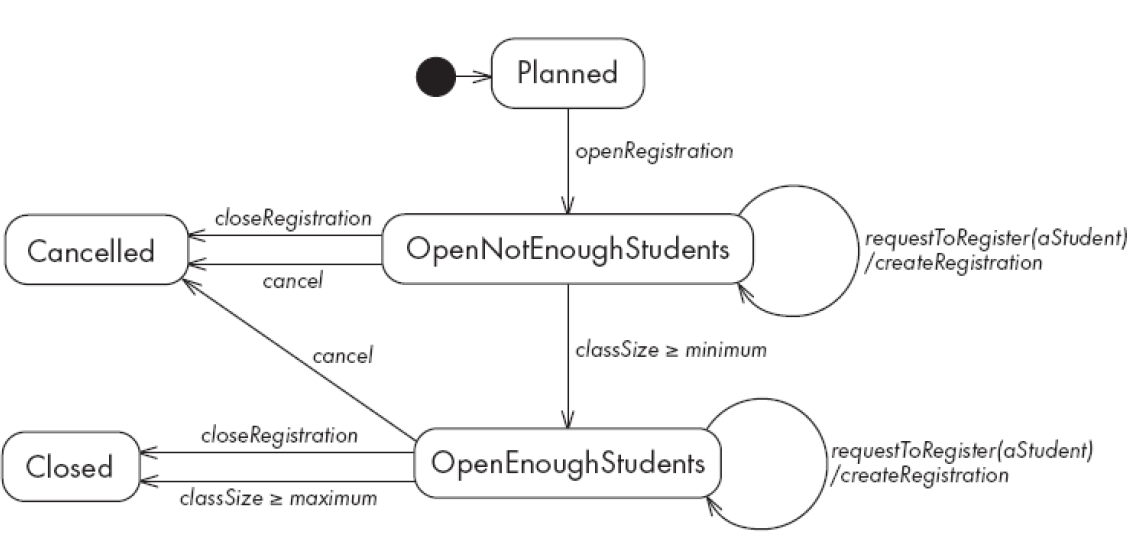
Actions in state diagrams¶
- An action is a block of code that must be executed effectively instantaneously
- When a particular transition is taken,
- Upon entry into a particular state, or
- Upon exit from a particular state
- An action should consume no noticeable amount of time
Nested substates and guard conditions¶
- A state diagram can be nested inside a state.
- The states of the inner diagram are called substates.
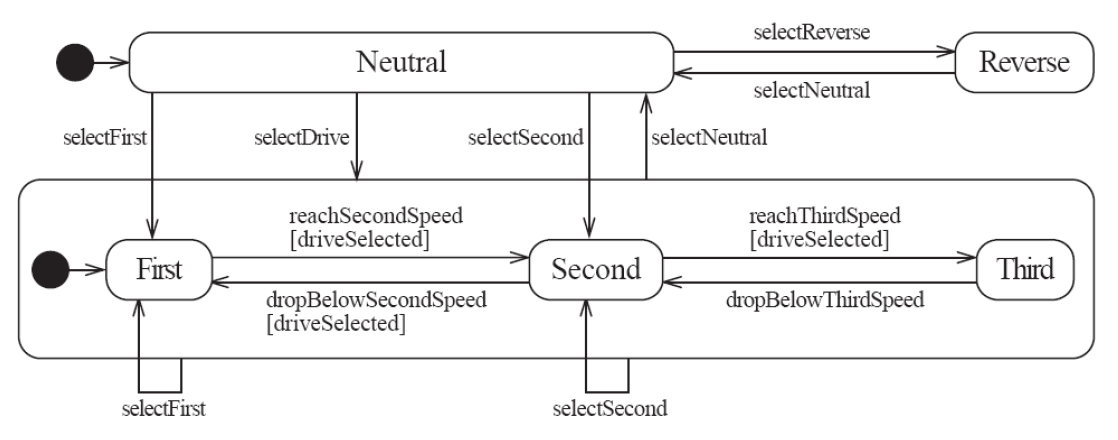
Nested state diagram – Another example¶
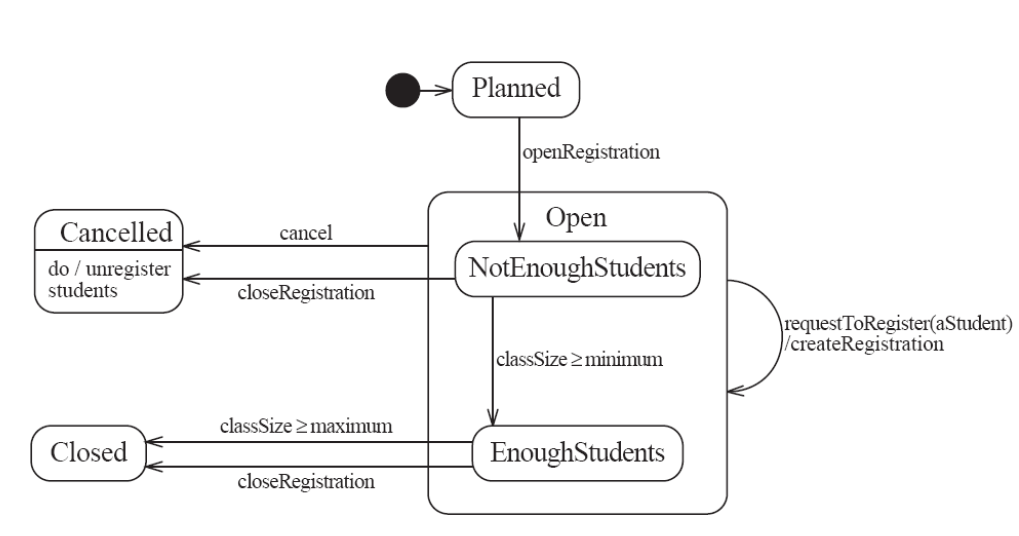
Auto-transitions¶
- A transition taken immediately upon entry into a state
- Unless guarded
- We will look at an example in the user manual
Events with parameters¶
- Parameters can be referenced in guards and actions.
- We will look at an example in the user manual.
Analysing models¶
Models can be analysed in several ways¶
- Visually
- Automatically generated errors and warnings
- State tables (next slide)\
- Metrics
- Formal methods (nuXMV)
State tables and simulations¶
- Allow analysis of state machines statically without having to write code
- We will explore these in UmpleOnline by looking at state machine examples and generating tables and simulations
Concurrency¶
Do activities and concurrency¶
- A do activity executes
- In a separate thread
- Until
- Its method terminates, or
- The state needs to exit (killing the tread)
- Example uses:
- Outputting a stream (e.g. playing music)
- Monitoring something
- Running a motor while in the state
- Achieving concurrency, using multiple do activities
Active objects¶
-
These start in a separate thread as they are instantiated.
-
Declared with the keyword
Default threading in state machines¶
- As discussed so far, code generated for state machines has the following behaviour:
- A single thread:
- Calls an event
- Executes the event (running any actions)
- Returns to the caller and continues
- This has two problems:
- If another thread calls the event at the same time they will interfere
- There can be deadlocks if an action itself triggers an event
Queued state machines¶
-
Solve the threading problem:
-
Callers can add events to a queue without blocking
-
A separate thread takes items off the queue ‘as fast as it can’ and processes them
-
Umple syntax:
queuedbefore the state machine declaration -
We will look at examples in the manual
Pooled state machines¶
- Default Umple Behavior (including with queued):
- If an event is received but the system is not in a state that can handle it, then the event is ignored.
- Alternative
pooledstereotype: - Uses a queue (see previous slide)
- Events that cannot be processed in the current state are left at the head of the queue until a relevant state reached
- The first relevant event nearest the head of the queue is processed
- Events may hence be processed out of order, but not ignored
Unspecified pseudo-event¶
-
Matches any event that is not listed
-
Can be in any state, e.g.
Example using unspecified¶
class AutomatedTellerMachine{
queued sm {
idle {
cardInserted -> active; maintain -> maintenance;
unspecified -> error1;
}
maintenance { isMaintained -> idle; }
active {
entry /{addLog("Card is read");}
exit /{addLog("Card is ejected");}
validating {
validated -> selecting;
unspecified -> error2;
}
selecting {select -> processing; }
processing {
selectAnotherTransiction -> selecting;
finish -> printing;
}
printing {receiptPrinted -> idle;}
cancel -> idle;
}
error1 {entry / {printError1();} ->idle;}
error2 {entry / {printError2();} ->validating;}
}
}
State machines in the user manual¶
State machine case study¶
State machine for a phone line¶
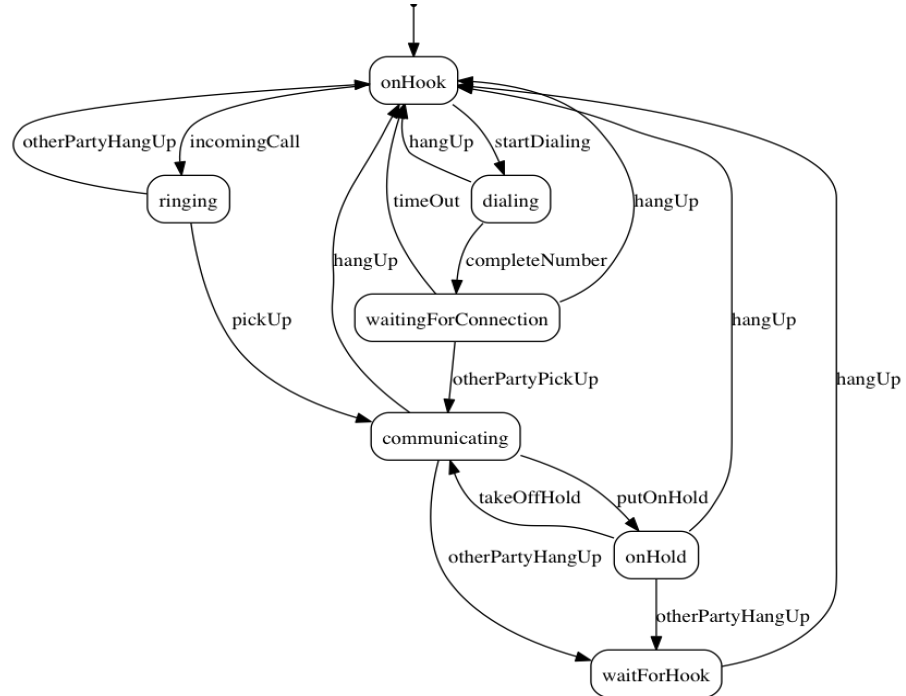
Umple for the phone line example¶
class phone {
state {
onHook {
startDialing -> dialling;
incomingCall -> ringing;
}
ringing {
pickUp -> communicating;
otherPartyHangUp -> onHook;
}
communicating {
hangUp -> onHook;
otherPartyHangUp -> waitForHook;
putOnHold -> onHold;
}
onHold {
hangUp -> onHook;
otherPartyHangUp -> waitForHook;
takeOffHold -> communicating;
}
- next slide
Umple for the phone line example¶
- con't.
dialing {
completeNumber ->
waitingForConnection;
hangUp -> onHook;
}
waitingForConnection {
otherPartyPickUp -> communicating;
hangUp -> onHook;
timeOut -> onHook;
}
waitForHook {
hangUp -> onHook;
}
}
}
In-class modeling exercise for state machines¶
- Microwave oven system state machine
- Events include
- pressing of buttons
- door opening
- door closing
- timer ending
- etc.
Mixins¶
Mixins : Motivation¶
-
Product variants have long been important for
-
Product lines/families, whose members target different:
- hardware, OS, feature sets, basic/pro versions
-
Feature-oriented development (separation of concerns)
Separation of concerns by mixins in Umple¶
-
Mixins allow including attributes, associations, state machines, groups of states, stereotypes, etc
-
Example:
-
The result would be a class with both a and b.
-
It doesn’t matter whether the mixins are
-
Both in the same file
- One in one file, that includes the other in an other file
- In two separate files, with a third file invoking them
Typical ways of using mixins¶
-
Separate groups of classes for
-
model (classes, attributes, associations)
-
Methods operating on the model
-
Allows a clearer view of the core model
-
Another possibility
-
One feature per file
Typical ways of using mixins¶
- Separate model files (classes, attributes associations)
- … from files for the same class containing methods
- Allows a clearer view of the core model
- Separate system features, each into a separate file
Advantages and disadvantages of mixins¶
-
Advantages:
-
Smaller files that are easier to understand
-
Different versions of a class for different software versions (e.g. a professional version) can be built by using different mixins
-
Disadvantage
-
Delocalization:
- Bits of functionality of a class in different files
- The developer may not know that a mixin exists unless a tool helps show this
Aspect orientation¶
Aspects : Motivation¶
- We often don’t quite like the code as generated
Or
- We want to do a little more than what the generated code does
Or
- We want to inject some feature (e.g. security checks) into many places of generated or custom code
Aspect orientation : General Concept¶
-
Create a pointcut that specifies (advises) where to inject code at multiple points elsewhere in a system
-
The pointcut uses a pattern
-
Pieces of code that would otherwise be scattered are thus gathered into the aspect
-
But: There is potentially acute sensitivity to change
-
If the code changes the aspect may need to change
-
Yet without tool support, developers wouldn’t know this
-
Drawback : Delocalization even stronger than for mixins
Aspect orientation in Umple¶
-
It is common to limit a pointcuts a single class
-
Inject code before, after, or around execution of custom or generated methods and constructors
class Person {
name;
before setName {
if (aName != null && aName.length() > 20) { return false;
}
}
}
- We have found these limited abilities nonetheless solve key problems
Traits¶
Traits : Motivation¶
-
We may want to inject similar elements into unrelated classes
-
without complex multiple inheritance
-
Elements can be
-
Methods
-
Attributes
-
Associations
-
States or state machines
-
.. Anything
Separation of Concerns by Traits¶
- Allow modeling elements to be made available in multiple classes
trait Identifiable {
firstName;
lastName;
address;
phoneNumber;
fullName = {firstName + " " + lastName}
Boolean isLongName() {return lastName.length() > 1;}
}
class Person {
isA Identifiable;
}
- See more complete version of this in the user manual
Another Trait example¶
trait T1{
abstract void method1(); /* required method */
abstract void method2();
void method4(){/*implementation – provided method*/ }
}
trait T2{
isA T1;
void method3();
void method1(){/*implementation*/ }
void method2(){/*implementation*/ }
}
class C1{
void method3(){/*implementation*/ }
}
class C2{ isA C1; isA T2;
void method2(){/*implementation*/ }
}
Traits With Parameters¶
trait T1< TP isA I1 > {
abstract TP method2(TP data);
String method3(TP data){ /*implementation*/ }
}
interface I1{
void method1();
}
class C1{ isA I1;
isA T1<TP = C1>;
void method1(){/*implementation*/}
C1 method2(C1 data){ /*implementation*/ }
}
class C2{
isA I1;
isA T1< TP = C2 >;
void method1(){/*implementation*/}
C2 method2(C2 data){ /*implementation*/ }
}
Trait Parameters in Methods¶
trait T1 <TP>{
String method1();
String method2(){
#TP# instance = new #TP#();
return method1() +":"+instance.process();
}
}
class C1{
String process(){/*implementation*/}
}
class C2{
isA T1< TP = C1 >;
String method1(){/*implementation*/ }
}
Selecting Subsets of Items in Traits¶
trait T1{
abstract method1();
void method2(){/*implementation*/}
void method3(){/*implementation*/}
void method4(){/*implementation*/}
void method5(){/*implementation*/}
}
class C1{
isA T1<-method2() , -method3()>;
void method1() {/*implementation related to C1*/}
}
class C2{
isA T1<+method5()>;
void method1() {
/*implementation related to C2*/}
}
Renaming Elements when Using Traits¶
trait T1{
abstract method1();
void method2(){/*implementation*/}
void method3(){/*implementation*/}
void method4(){/*implementation*/}
void method5(Integer data){/* implementation*/}
}
class C1{
isA T1< method2() as function2 >;
void method1() {/*implementation related to C1*/}
}
class C2{
isA T1< method3() as private function3 >;
void method1() {/*implementation related to C2*/}
}
class C3{
isA T1< +method5(Integer) as function5 >;
void method1() {/*implementation related to C3*/}
}
Associations in Traits: Observer Pattern¶
class Dashboard{
void update (Sensor sensor){ /*implementation*/ }
}
class Sensor{
isA Subject< Observer = Dashboard >;
}
trait Subject <Observer>{
0..1 -> * Observer;
void notifyObservers() { /*implementation*/ }
}
Using Traits to Reuse State Machines¶
trait T1 {
sm1{
s0 {e1-> s1;}
s1 {e0-> s0;}
}
}
trait T2 {
isA T1;
sm2{
s0 {e1-> s1;}
s1 {e0-> s0;}
}
}
class C1 {
isA T2;
}
Satisfaction of Required Methods Through State Machines¶
trait T1{
Boolean m1(String input);
Boolean m2();
sm1{
s1{
e1(String data) -> /{ m1(data); } s2; }
s2{
e2 -> /{ m2(); } s1; }
}
}
class C1{
isA T1;
sm2{
s1{ m1(String str) -> s2;}
s2{ m2 -> s1;}
}
}
Changing Name of a State Machine Region¶
trait T1{
sm {
s1{
r1{ e1-> r11; }
r11{}
||
r2{ e2-> r21; }
r21{}
}
}
}
class C1{
isA T1<sm.s1.r1 as region1,sm.s1.r2 as region2>;
}
Changing the Name of an Event¶
trait T1 {
sm1{
s0 { e1(Integer index)-> s1;}
s1 {e0-> s0;}
}
sm2{
t0 {e1(Integer index)-> t1;}
t1 {e0-> t0;}
}
}
class C1 {
isA T1<sm1.e1(Integer) as event1, *.e0() as event0>;
}
Mixins and Traits together¶
- Examples of mixins and traits combined in the user manual:
- Mixins with traits:
- https://cruise.umple.org/umple/TraitsandUmpleMixins.html
Mixsets¶
Mixsets: Motivations¶
-
A feature or variant needs to inject or alter code in many places
-
Historically tools like the C Preprocessor were used
-
Now tools like "Pure: Variants"
-
There is also a need to
-
Enable model variants in a very straightforward way
- Blend variants with code/models in core compilers
- With harmonious syntax + analysable semantics
- Without the need for tools external to the compiler
Mixsets: Top-Level Syntax¶
- Mixsets are named sets of mixins
- The following syntactic sugar works for top level elements (class, trait, interface, association, etc.)
Use Statements¶
- A use statement specifies inclusion of either
- A file, or
- A mixset
- A mixset is conceptually a
virtual filethat is composed of a set of model/code elements - The use statement for a mixset can appear
- Before, after or among the definition of the mixset parts
- In
another mixset - On the command line to generate a variant
Mixsets and Mixins: Synergies¶
- The blocks defined by a mixset are mixins
- Mixsets themselves can be composed using mixins
- e.g.
- And somewhere else
- Would be the same as:
Mixset Definitions Internal to a Top-Level Element¶
- Is the same as,
- The above works for attributes, associations, state machines, states, etc.
Motivating Example: Umple Model/Code for Basic Bank¶
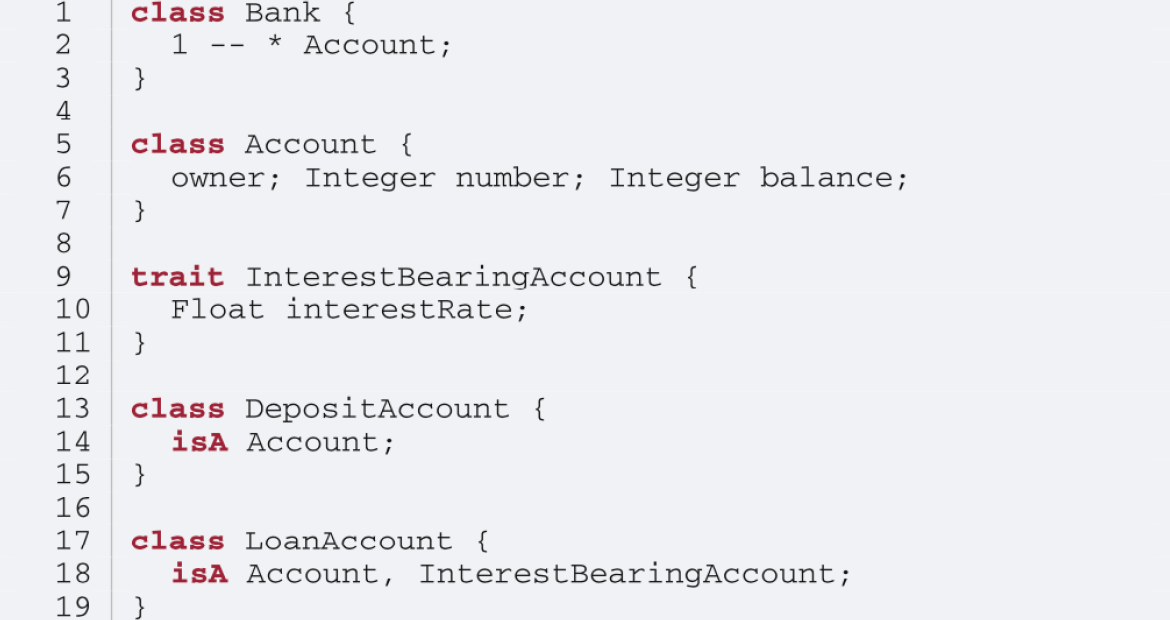
Class Diagram of Basic Bank Example:¶
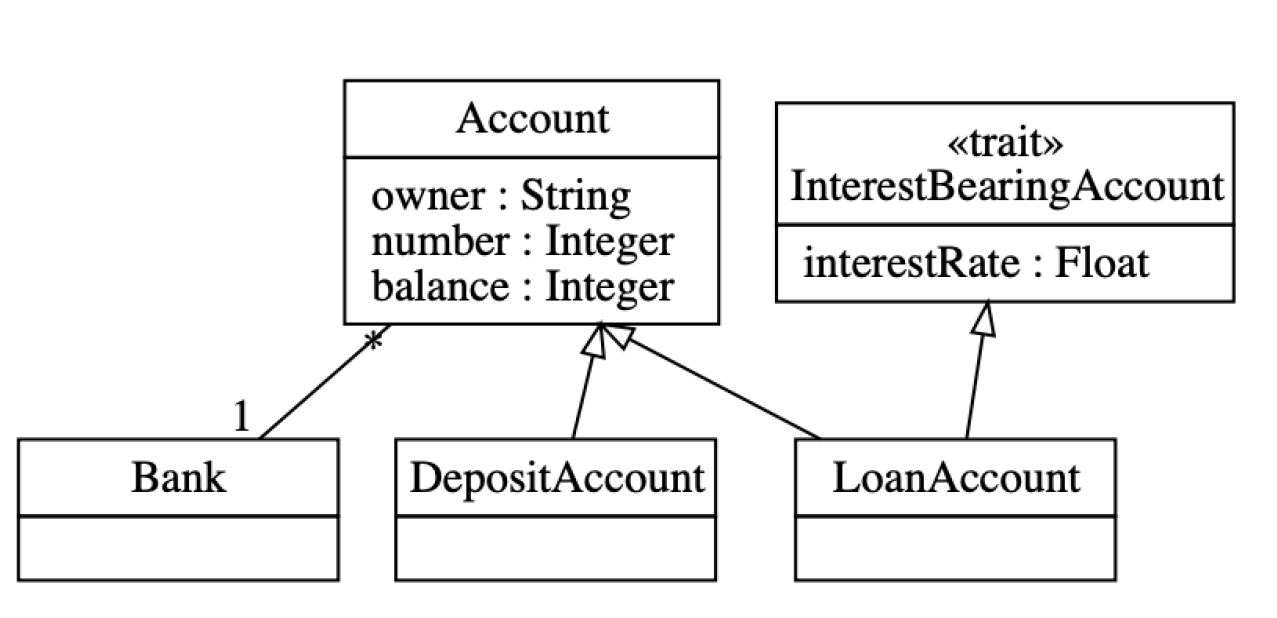
Adding Optional Multi-branch Feature¶
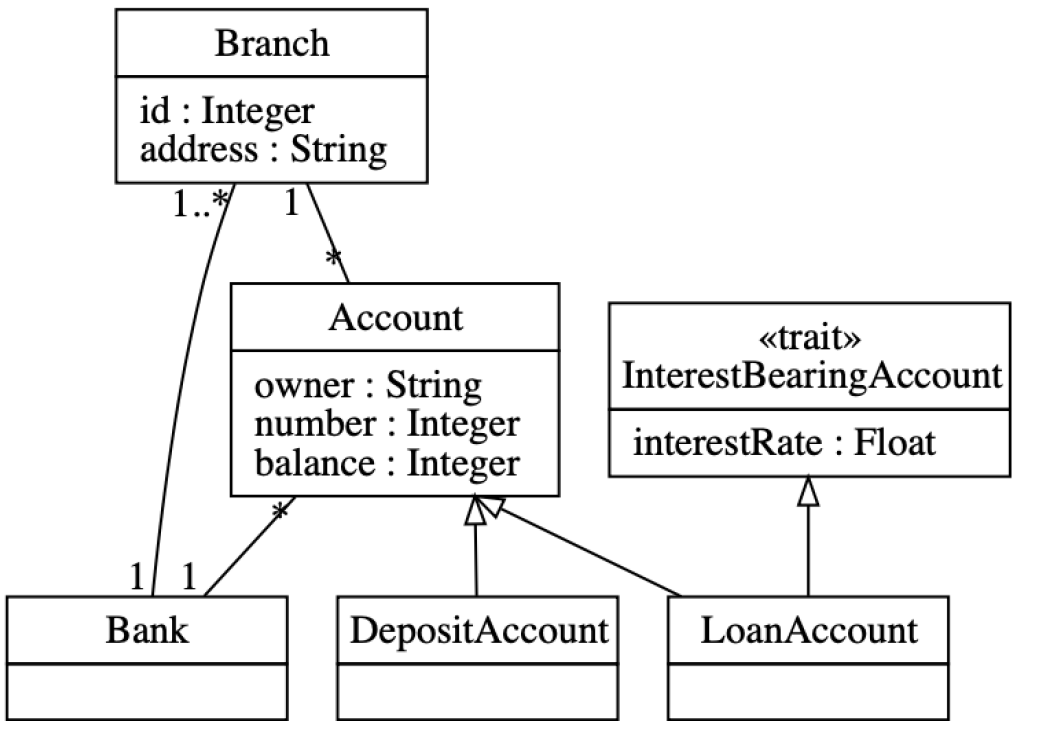
Example: Multi-branch Umple Model/Code¶
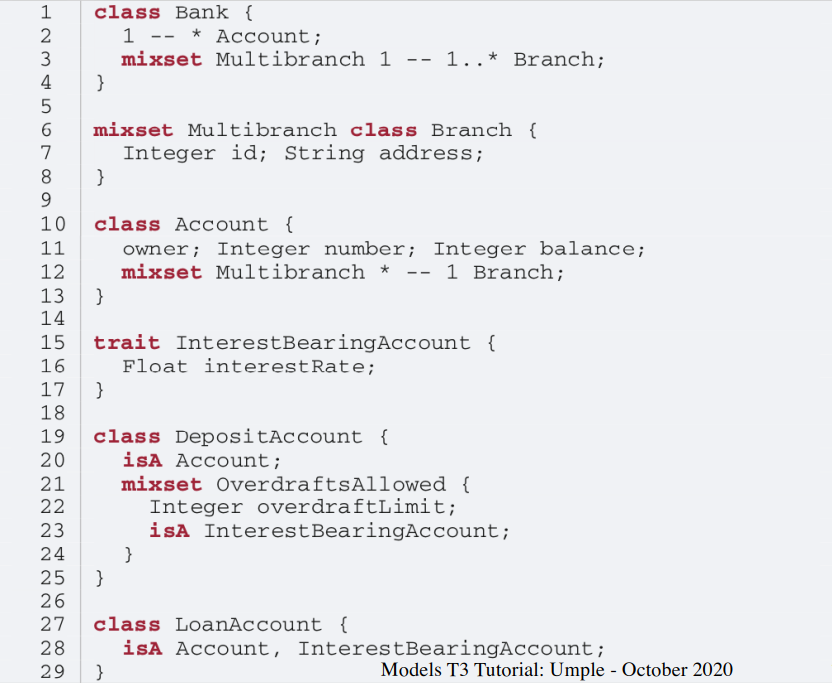
Alternative Approach (same system)¶
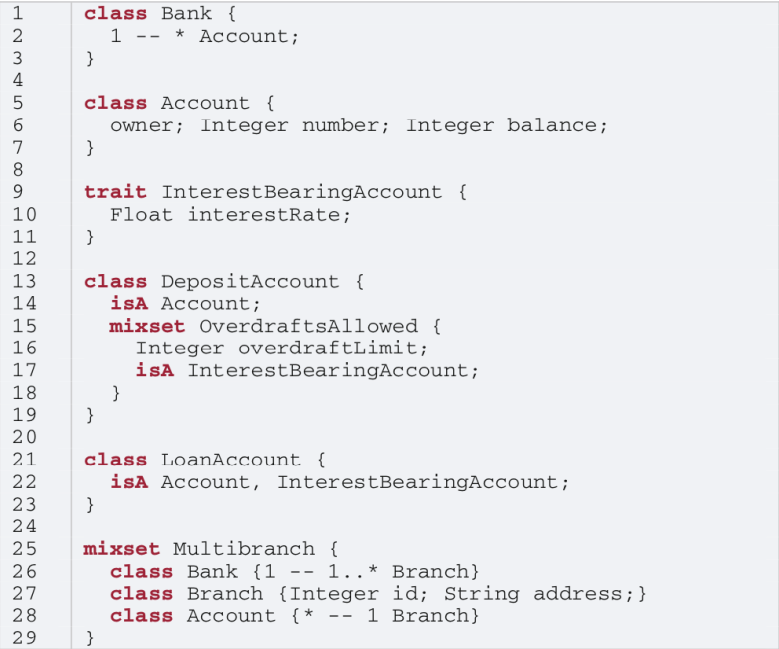
Constraints on Mixsets¶
-
Allowed operators
-
and, or, xor
-
not
-
n..m of {…}
-
Parentheses allowed
opt X (means 0..1 of {X})
Case Study and Exercise 1: Modifying the banking example¶
- I will give you the text of the banking example and set up a task for you to:
- Add the ability to have one or more account holders
- Add the ability to have one or more co-signers
Case Study and Exercise 2: Dishwasher example¶
- We will start with the Dishwasher example in UmpleOnline
- We will use UmpleOnline’s Task capability to ask you to split the Dishwasher example into two versions
- A cheap version that only does normal wash and not fast wash
- A full version that does everything
- Hint: Pull out the relevant state and transition for fast wash and wrap it in a mixset
Case Study 3: Umple itself, written in Umple¶
- We will look at:
- Code in Github
- Generated Architecture diagrams
- Generated Javadoc
- Sample master code
- Sample test output
- Sample code for generators (that replaced Jet)
- UmpleParser (that replaced Antlr
Unit Testing with UMPLE¶
Unit Testing with Umple¶
- To see how to integrate Unit Testing with Umple, see the sample project at
- https://github.com/umple/umple/tree/master/sandbox
- And the build script at
- https://github.com/umple/umple/blob/master/build/build.sandbox.xml
- Command line from build directory
A Look at How Umple is Written in Itself¶
- Source:
- https://github.com/umple/umple/tree/master/cruise.umple/src
- Umple’s own class diagram generated by itself from itself:
- http://metamodel.umple.org
- Colours represent key subsystems
- Click on classes to see Javadoc, and then Umple Code
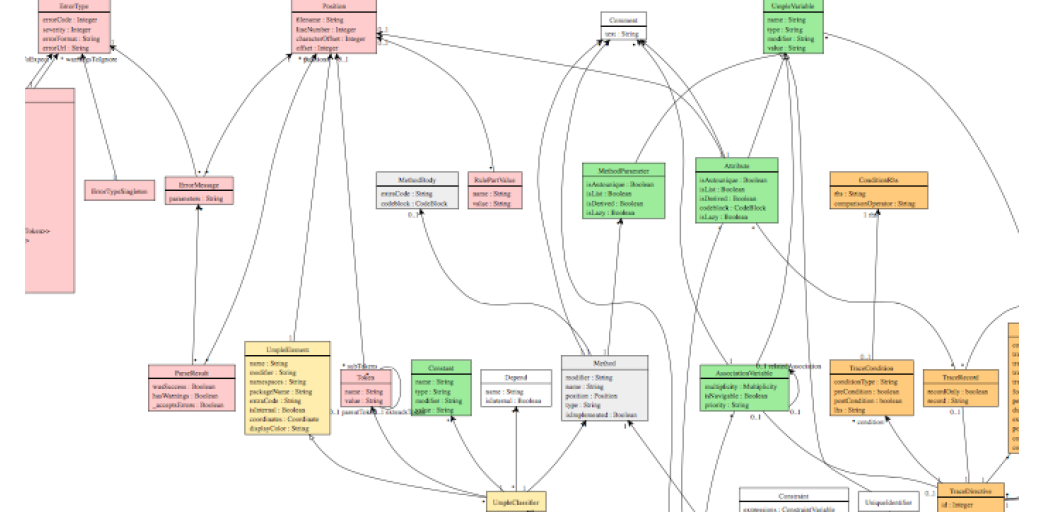
Testing: TDD with100% pass always required¶
- Multiple levels: https://cruise.eecs.uottawa.ca/qa/index.php
- Parsing tests: basic constructs
- Metamodel tests: ensure it is populated properly
- E.g.
- https://github.com/umple/umple/blob/master/cruise.umple/test/cruise/umple/compiler/AssociationTest.java
- Implementation template tests: to ensure constructs generate code that looks as expected
- Testbed semantic tests: Generate code and make sure it behaves the way it should
UMPLE issues list¶
UMPLE issues list¶
- Tagged by
- Priority
- Perceived difficulty
- Scale (bug, project, research project)
- Milestone (slow release)
Using Umple with Builds and Continuous Integration¶
Using Umple with Builds and Continuous Integration¶
- Example build scripts
- Example travis.yml
- Umple’s own Travis page

UMPLE's Architecture¶
Umple's Architecture¶
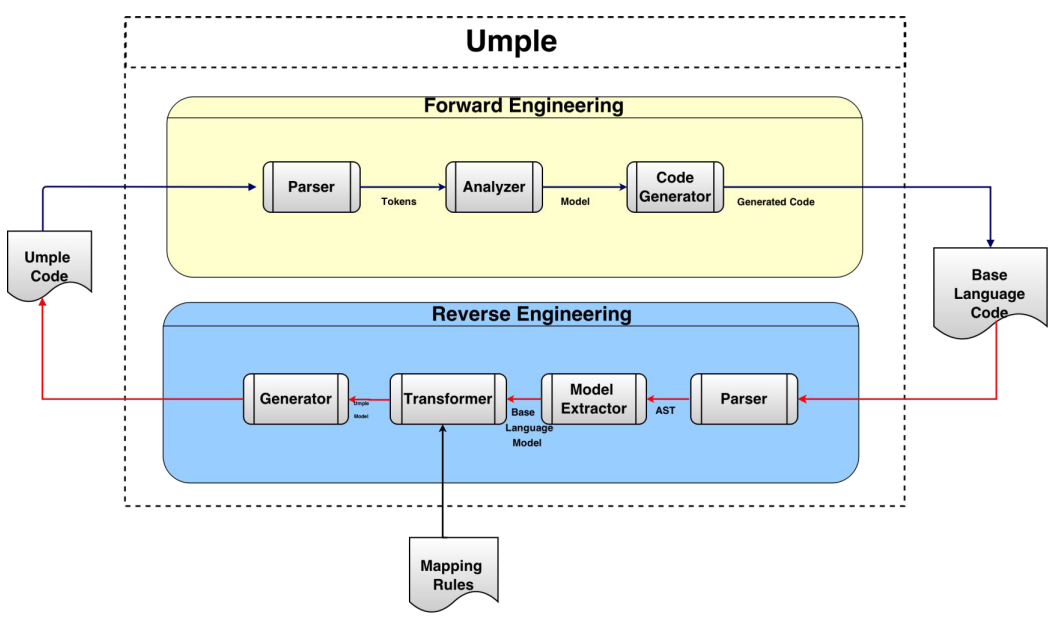
Umplification¶
Umplification¶
-
Umplification: ‘amplication’ + converting into Umple.
-
Produces a program with behavior identical to the original one but written in Umple.
-
Eliminates the distinction between code and model. Proceeds incrementally until the desired level of abstraction is achieved.
Umplification: The Transformation Steps¶
- Transformation 0: Initial transformation
- Transformation 1: Transformation of generalization, dependency, and namespace declarations.
- Transformation 2: Analysis and conversion of many instance variables, along with the methods that use the variables.
- Transformation 2a: Transformation of variables to UML/Umple attributes.
- Transformation 2b: Transformation of variables in one or more classes to UML/Umple associations.
- Transformation 2c: Transformation of variables to UML/Umple state machines.
Umplification Process¶
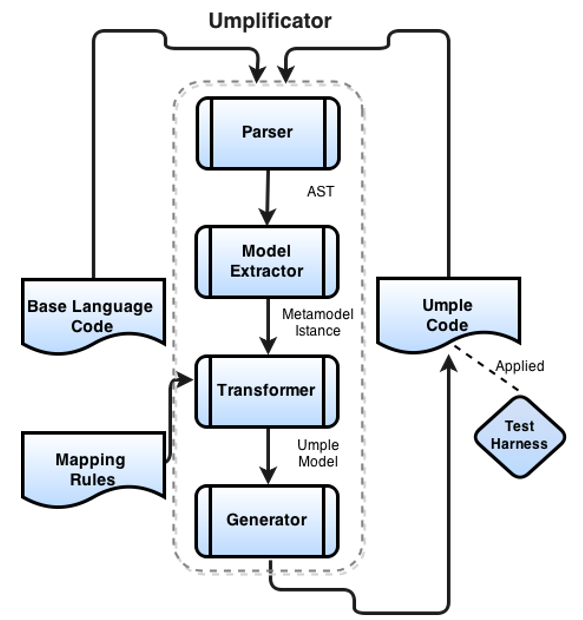
Umplificator Architecture¶
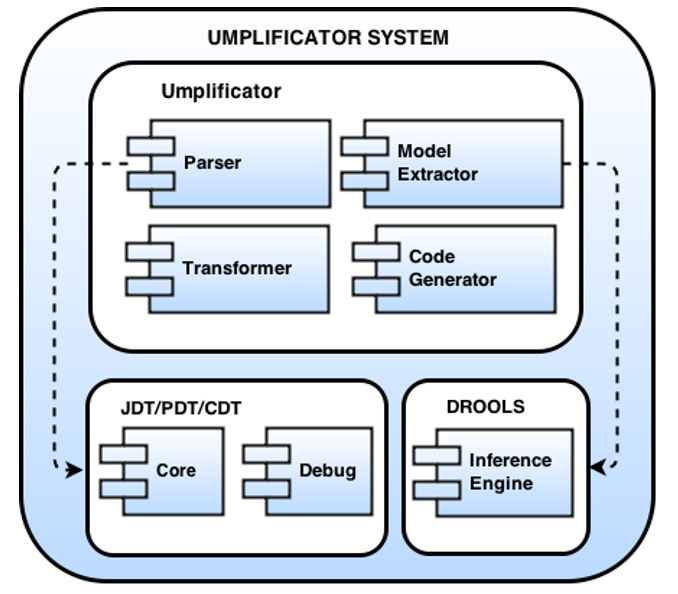
Umplification - Example¶

Umplification - Example¶
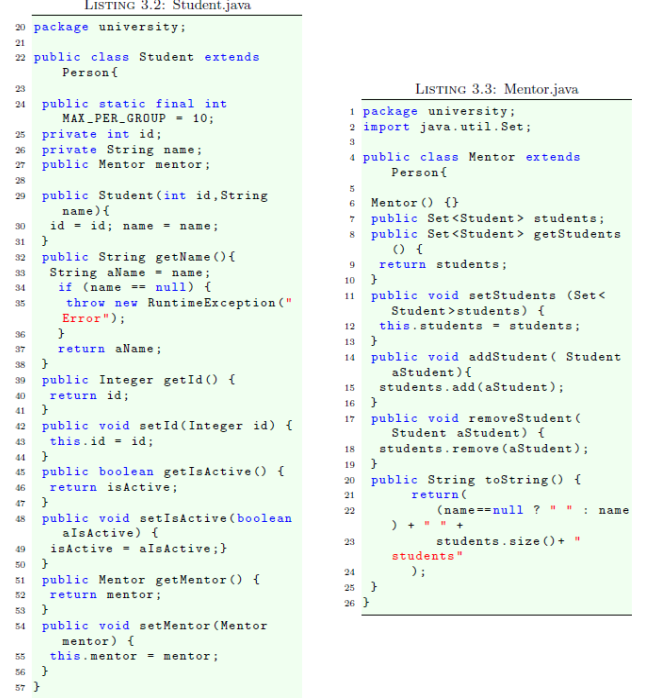
Systems umplified (JhotDraw 7.5.1)¶
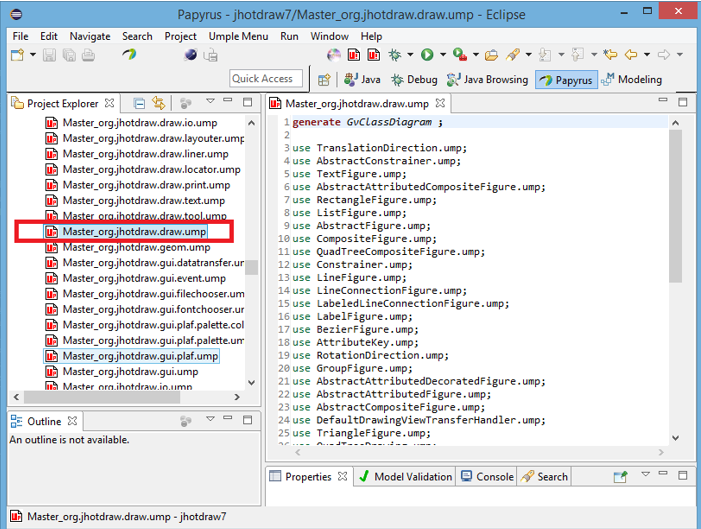
Systems umplified (JhotDraw 7.5.1)¶
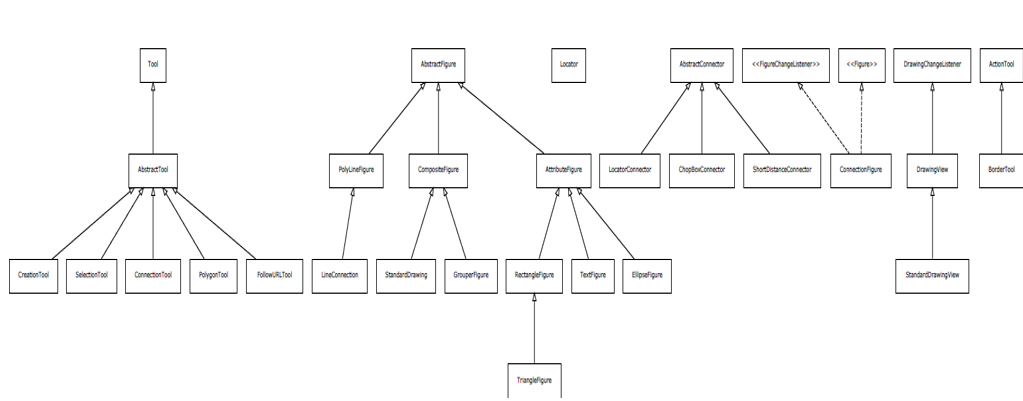
Systems umplified¶
-
Weka
-
Associations umplified
-
Args4J- Modernization
-
Original Args4j source code is composed of 61 classes and 2223 LOC.
-
Umplified Args4j source code is composed of 122 (2 per input class) umple files and 1980 LOC.
-
# LOC in files containing modeling constructs (X.ump) is 312.
-
# LOC in files with algorithmic/logic code (X code.ump) is 1668.
The developer must then translate 1518 lines of code rather than 2223 lines of code.
Conclusion¶
Conclusion¶
- Umple
- Is simple but powerful modeling tool
- Generates state-of-the-art code
- Enables agility + model-driven development
- We call the overall approach model-based programming
Umple Examples More ..¶
- http://try.umple.org
- https://github.com/umple/umple/wiki/examples
- http://umpr.a4word.com/
- http://code.umple.org
- http://metamodel.umple.org
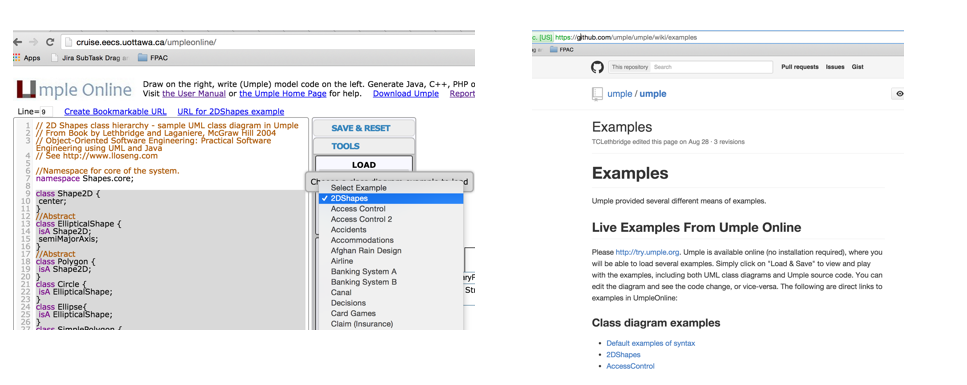
References¶
References¶
- UMPLE Tutorials
- UMPLE Github
- UMPLE Online
- UMPLE Documentation
- UMPLE CSI5112– February 2018
- Umple Tutorial: Models 2020 Web
- Umple Tutorial: Models 2020 Pdf
References¶
- Getting Started in UMPLE
- Experiential Learning for Software Engineering Using Agile Modeling in Umple (Youtube)
- Experiential Learning for Software Engineering Using Agile Modeling in Umple (Slide)
- Tomassetti Code Generation
\(End-Of-Week-7\)